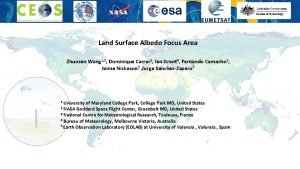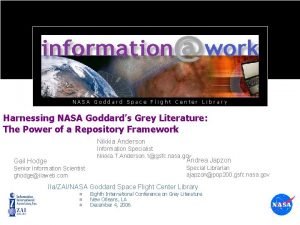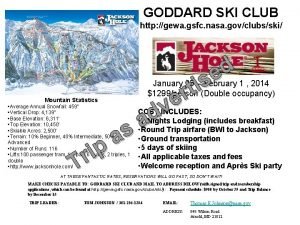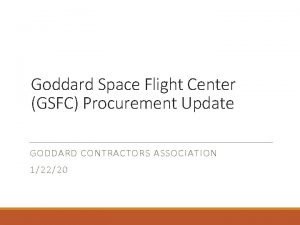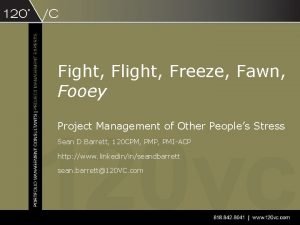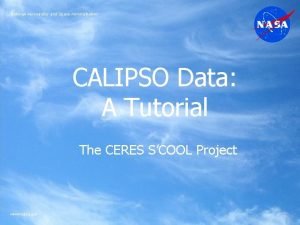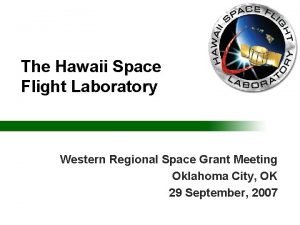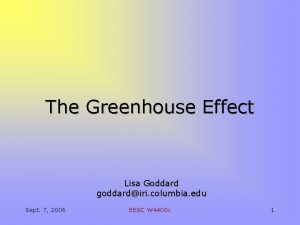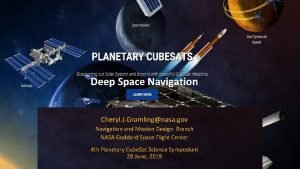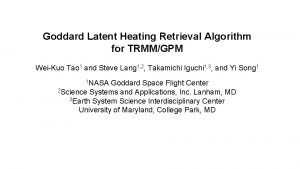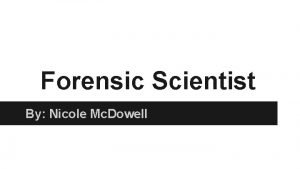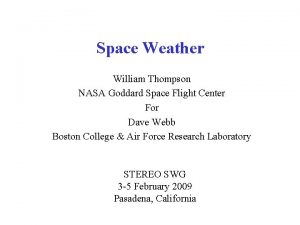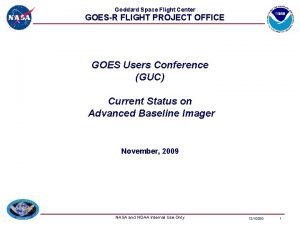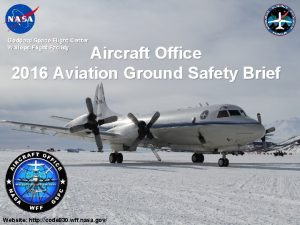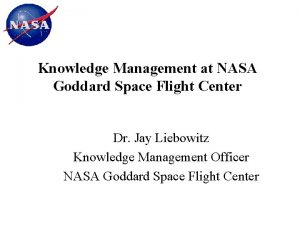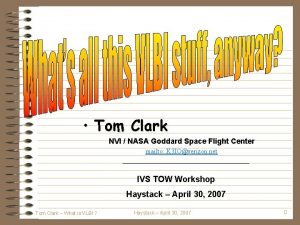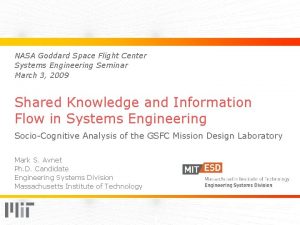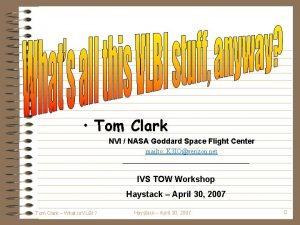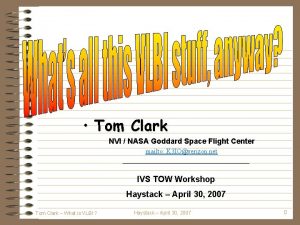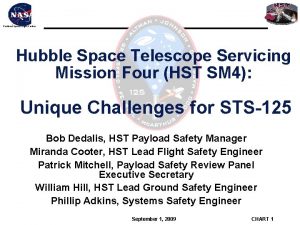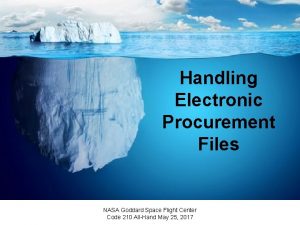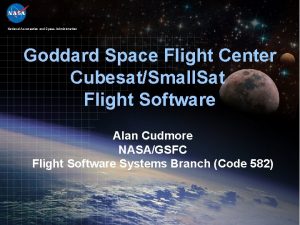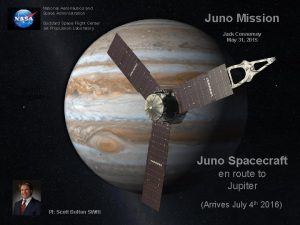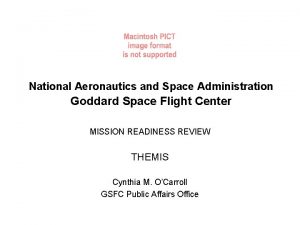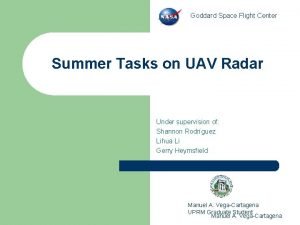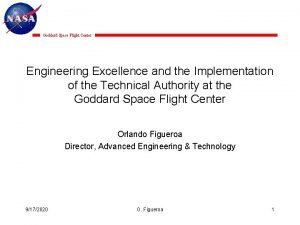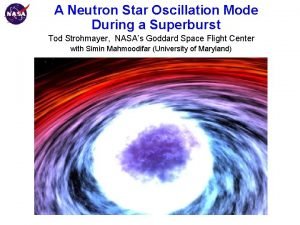Goddard Space Flight Center Why NASA Needs Solar




















- Slides: 20

Goddard Space Flight Center Why NASA Needs Solar Cycle Predictions W. Dean Pesnell NASA, Goddard Space Flight Center Project Scientist, Solar Dynamics Observatory Member, Solar Cycle 24 Prediction Panel Space Weather Workshop, April 2007, W. Dean Pesnell, GSFC 1

Goddard Space Flight Center NASA’s mandate is to build, fly, and operate spacecraft in the hostile environment of space. Our success comes from trying to understand what can go wrong and building and operating appropriate payloads. Things go right, things go worng, but the mandate is still there. Space Weather Workshop, April 2007, W. Dean Pesnell, GSFC 2

Goddard Space Flight Center Solar Cycle Predictions are needed to l Anticipate orbital decay and needs for reboosting l Anticipate radiation exposure for upcoming missions Space Weather Workshop, April 2007, W. Dean Pesnell, GSFC 3

Goddard Space Flight Center Solar Cycle Predictions are needed to l Anticipate orbital decay and needs for reboosting l Anticipate radiation exposure for upcoming missions l Satisfy our scientific curiosity Space Weather Workshop, April 2007, W. Dean Pesnell, GSFC 4

Mission Operations must Understand Atmospheric Drag Goddard Space Flight Center l l Space Weather Workshop, April 2007, W. Dean Pesnell, GSFC Drag affects every object in low-Earth Orbit Operating satellites may require boosting to stay in a usable orbit (ISS, Hubble) 5

Mission Operations must Understand Atmospheric Drag Goddard Space Flight Center l l Space Weather Workshop, April 2007, W. Dean Pesnell, GSFC Large satellites without propulsion must be monitored to assure a safe re-entry (UARS) Knowledge of orbital debris is also required (rated as one of the biggest hazards to spaceflight) 6

Goddard Space Flight Center Mission Planning must Allow for Atmospheric Drag Changes of the Jacchia model exospheric temperature with solar and geomagnetic activity. Mission planners must have some way to estimate future activity. Space Weather Workshop, April 2007, W. Dean Pesnell, GSFC 7

Goddard Space Flight Center l Radiation Hazards must be Understood to be Mitigated Radiation hazard is different for every orbit and duration – Incident particles range from cosmic rays to highly-relativistic electrons to solar protons l l l Missions can have a 10 -year leadtime, the Heliophysics Roadmap shows missions out to 2020! An understanding of the hazard in each of various study orbits may determine how the mission is designed Near-real-time knowledge of radiation hazard is also required – This requires short-term predictions of activity Space Weather Workshop, April 2007, W. Dean Pesnell, GSFC 8

Goddard Space Flight Center Cosmic Rays and the Solar Cycle Space Weather Workshop, April 2007, W. Dean Pesnell, GSFC 9

Goddard Space Flight Center Other Radiation Comes from the Sun and Magnetosphere A CME strikes the Earth’s magnetosphere. Both prompt (SEPs) and delayed (magnetospheric storms) radiation increases are possible. Space Weather Workshop, April 2007, W. Dean Pesnell, GSFC 10

Goddard Space Flight Center Space Weather Workshop, April 2007, W. Dean Pesnell, GSFC 11

Who Wouldn’t Want to Solve a Century-old Puzzle Goddard Space Flight Center l l l Flares and coronal mass ejections are the origins of space weather—but we still don’t know how to predict either! Simple timeseries analysis has not produced accurate predictions, additional information is required Solar activity comes from the dynamo within the convection zone and reaches out through the photosphere into the corona Many models of the solar dynamo exist but none are complete We have seen part of the solution: helioseismology and large-scale numerical models Space Weather Workshop, April 2007, W. Dean Pesnell, GSFC 12

Flows in the Solar Convection Zone Goddard Space Flight Center These flows, which are being resolved by helioseismology, have been observed for one solar cycle. They constantly change with the cycle and may be the clue to the solar dynamo. Space Weather Workshop, April 2007, W. Dean Pesnell, GSFC 13

Goddard Space Flight Center The Solar Dynamics Observatory SDO, the first mission of Living With a Star, will provide the data needed to understand the solar convection zone and how magnetic field is assembled and dissipated in the solar atmosphere. But that’s another story! Space Weather Workshop, April 2007, W. Dean Pesnell, GSFC 14

Questions? Goddard Space Flight Center Space Weather Workshop, April 2007, W. Dean Pesnell, GSFC 15

Goddard Space Flight Center Backup Slides Follow Space Weather Workshop, April 2007, W. Dean Pesnell, GSFC 16

Goddard Space Flight Center Space Weather Workshop, April 2007, W. Dean Pesnell, GSFC 17

Babcock-Leighton model Goddard Space Flight Center Space Weather Workshop, April 2007, W. Dean Pesnell, GSFC 18

Goddard Space Flight Center Space Weather Workshop, April 2007, W. Dean Pesnell, GSFC 19

Goddard Space Flight Center Space Weather Workshop, April 2007, W. Dean Pesnell, GSFC 20
 Albedo
Albedo Goddard space flight center library
Goddard space flight center library Nasa goddard ski club
Nasa goddard ski club Goddard contractors association
Goddard contractors association Andreas carlsson bye bye bye
Andreas carlsson bye bye bye Flight flight freeze fawn
Flight flight freeze fawn Sampung halimbawa ng bulong
Sampung halimbawa ng bulong Nasa www.nasa.gov
Nasa www.nasa.gov Primary needs and secondary needs
Primary needs and secondary needs Primary needs and secondary needs
Primary needs and secondary needs Simple claustral complex
Simple claustral complex Strategic gender needs and practical gender needs
Strategic gender needs and practical gender needs Wants in esp
Wants in esp Space a flights to hawaii
Space a flights to hawaii Wholesale solar controller
Wholesale solar controller An inexhaustible source of energy
An inexhaustible source of energy Lisa goddard iri
Lisa goddard iri Cheryl goddard
Cheryl goddard Goddard heating and air
Goddard heating and air Father of bloodstain identification
Father of bloodstain identification Fiona goddard
Fiona goddard
